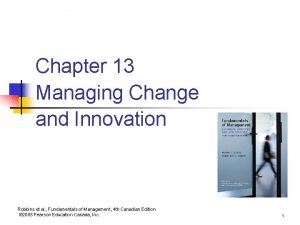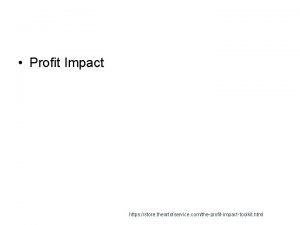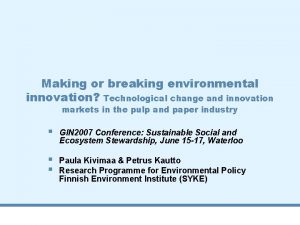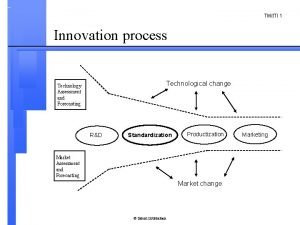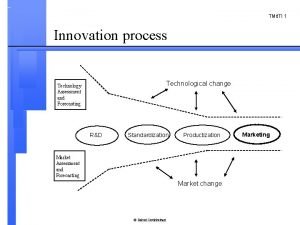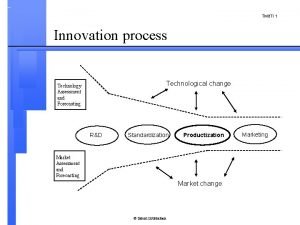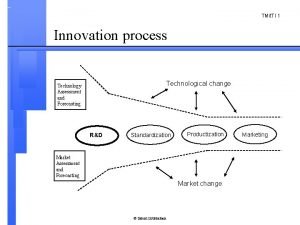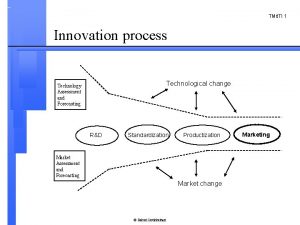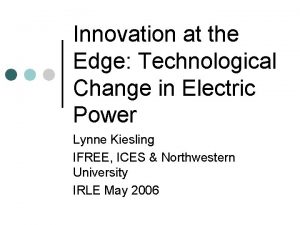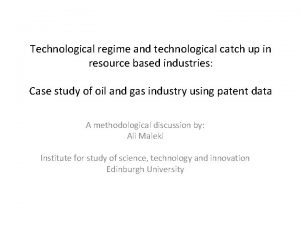Technological change and innovation in energy market impact























- Slides: 23

Technological change and innovation in energy market: impact of the price cap British Institute of Energy Economics conference Tuesday 18 th September 2018 Philip O’Donnell, Which? October 2021 1

About Which? § Which? is the largest consumer organisation in the UK – more than 1. 3 million members and supporters § We are an independent, apolitical, social enterprise working for all consumers and receive no government money, public donations, or other fundraising income § Within this, the Which? Policy team uncovers consumer detriment across the economy, using six ‘strategic themes’ to guide our priorities § We contribute thought leadership in emerging areas of consumer concern and build a robust evidence base to inform our public advocacy activity and shape/deliver tangible improvements for consumers October 2021 2

Which? and energy § Which? has long been active in energy policy: § Campaigns: Fair Energy Prices, Broken Energy Market, Cut Energy Prices § Surveys: Energy supplier satisfaction § Reviews: Which? Recommended Provider § Consumer tools: Which? Switch § Advocacy: Parliament, Govnt, regulators and industry; consultation responses; Policy reports § Research: Single Unit Pricing (with EDF) § Analysis: Market monitoring, Consumer Insight Tracker (worry, trust) October 2021 3

Which? – importance of innovation in energy § Which? is concerned that energy market is not delivering good outcomes for majority of consumers § Agree with CMA that weak competition and low consumer engagement mean that consumers who fail to engage in the market face excessively high prices § Concerned about potential unintended consequences of price cap – as a result, Which? set out five key “tests” for price cap, including on innovation § The Domestic Gas & Electricity (Tariff Cap) Bill contains no specific incentive for innovation…which is assumed to occur through competition October 2021 4

Energy and innovation – scope of project § Which? commissioned report from Cornwall Insight to provide additional evidence for response to Ofgem’s June 2018 consultation on the price cap § Methodology involved desk research, interviews with sector participants and case studies of other relevant markets § Key questions to answer: 1. How does current regulatory framework support and incentivise innovation in energy sector? 2. What innovations and technological changes are happening in energy market, and how could these be impacted by the price cap? 3. What lessons have been learned in other relevant markets or countries with price caps in place, and what have been impacts on innovation? October 2021 5

How is innovation supported in current regulatory framework? October 2021 6

Innovation in current framework: (R)Evolution? Evolution of existing products and services Revolution of new product and service offerings - Typically undertaken by incumbent suppliers and others already active in sector - Typically results from market disruption of business practices and models, and/or new entrants - Usually achieved within current regulatory regime, or unlikely to require extensive regulatory change - Usually requires regulatory framework to adapt/evolve to be more flexible and facilitate entry - Examples: smart home devices, bundling of services, app-based tools - Examples: peer-to-peer (P 2 P) trading, localised generation/supply October 2021 7

Innovation in current energy market Generation & transmission Consumption Purchase Icons made by Smashicons from www. flaticon. com Supply Storage October 2021 8

Innovation in current market: Conclusions § Combination of smart meters and To. U tariffs has considerable potential for innovation, but realising this conditional on greater customer engagement § Growth of domestic storage moving in step with small-scale generation assets (e. g. roof-mounted solar), but current costs proving prohibitive § Technological and commercial innovation evident in local energy market initiatives, typically developed in response to a specific local need or objective § For electricity networks, transition from national to local-level management increases need for network flexibility and accommodating low-carbon generation, which will increase impetus for innovation October 2021 9

How will innovation be affected by the default tariff cap? October 2021 10

Innovation & price cap: influencing factors Catalyst Inhibitor …if cap is seen as enduring rather than transitory measure Consumer engagement …increased exit of smaller suppliers, if not able to preserve slim margins Supplier reaction …increased consolidation, leading to reduction in consumer choice Market conditions …forces more rapid innovation as needs and customer demands evolve …lower-cost suppliers use cost advantage to extend offerings …increased (non-)price competition, as suppliers innovate and try to differentiate …suppliers with smaller SVT base SVT customer …suppliers with large SVT base will have cannot survive margin squeeze base to innovate to retain customers …constraints on financial capacity to invest and innovate Profitability …non-default tariff customers promotes engagement and broader bundling offer October 2021 11

Impact of price cap on innovation: Conclusions § Suppliers face strategic choice in their response to price cap: short-term cost reductions or long-term diversification § How suppliers make this choice likely to depend on a range of factors, including size and proportion of customers on default tariffs § Underlying trend of innovation expected to continue under price cap, though possible acceleration/slowing depends on supplier responses and ability to adapt § Supplier landscape already changing – larger suppliers losing customers and changing policy on default tariffs, while mergers and consolidation set to continue October 2021 12

What lessons can we learn from other markets? October 2021 13

Case studies: Other price-capped markets § Looked at six other comparator markets, with price caps in place: § Pre-payment Meter (PPM) energy cap, GB § Domestic energy market, Northern Ireland § “Tutela simile” domestic electricity tariff, Italy § Retail energy market, California § Water and sewerage retail supply, England & Wales § Broadband telephony, UK § Today, focus on two in particular: PPM and Italian market October 2021 14

Case study: PPM energy cap, GB § Around 4 m PPM customers originally covered by cap (April 2017); extended to cover further 2 m Warm Home Discount (WHD) customers at end of 2017 § Supplier behaviour differed by size – pricing of large & medium suppliers clustered at/near the cap, while smaller suppliers tended to be £ 40 -60 below § Due to reduced price dispersion of tariffs, suppliers differentiated in other ways (e. g. online account management, smart meter tariffs, diversification) § Overall, positive impact on innovation, as a result of increased competition among suppliers on non-price factors October 2021 15

Case study: ‘Tutela simile’ electricity tariff, Italy § In Italy, electricity price controls intended to protect customers, while serving as transitional arrangement to full market opening, scheduled for 2019 § Smart meter rollout more advanced in Italy (started in 2001, 35 m installed by 2017) and To. U (two-rate) tariffs mandatory for some customers (28 m) § However, higher penetration of smart meters has not increased switching – incumbent supplier (Enel) retains 86% market share § Despite lack of competition, Enel has stressed commitment to innovation (e. g. targets for DSR capacity, low-carbon transport, smart lighting, battery storage) October 2021 16

Conclusions October 2021 17

Conclusions: implications & challenges for Ofgem § Communicate transitory nature of price cap and encourage increased consumer engagement, alongside smart meter rollout; § Ensure proactive regulatory regime to encourage both evolution of products, and revolution (through market disruptors, and use of ‘sandbox’); § Minimise regulatory uncertainty by communicating effectively to both suppliers and consumers on cap removal and updates; and § Provide clarity on how forthcoming policy changes will interact with one another and the price cap October 2021 18

Conclusions: implications for Which? § Despite impending price cap, continue to encourage consumers to engage with market and support them in choosing best deal for their energy supply § Work with others to ensure implementation of measures to support innovation (e. g. midata, Smart Data Review) are facilitated in best way possible § Encourage Ofgem to facilitate innovation in best interests of consumers, balancing consumer protection with space to allow testing of new business models October 2021 19

Questions? October 2021 20

Annex October 2021 21

Annex: Default tariff cap – overview § The default tariff cap will cover all households in England, Wales and Scotland who are currently on an SVT or other default energy tariff § As with the PPM cap, the choice of 2020 as its initial expiration date is linked to the timescale for the roll-out of smart meters § The cap will be reviewed every six months with a view to resetting it if judged necessary § In setting the cap, Ofgem must consider the need to set it at a level that enables suppliers to “compete effectively for supply contracts”, as well as “the need to maintain incentives for customers to switch and the need to ensure that efficient suppliers are able to finance their supply activities”. § Although it will be in place until 2020, after this date Ofgem will recommend whether it should be extended annually up to 2023 October 2021 22

Which? response to price cap consultation Which? ’s response to Ofgem consultation on the price cap outlines three key issues: 1. We are concerned at lack of evidence Ofgem has provided regarding what consumers think about price cap and how it will affect them. Ofgem must monitor consumer behaviour in response to price cap to fully understand implications and to determine impact of cap on consumer detriment. 2. We are concerned that consultation does not cover how cap will be communicated to consumers. Given the potential for price cap to have adverse effect on consumer engagement, how it is communicated will be critical to how consumers respond and therefore overall effect. 3. The energy market is evolving in ways that could not have been thought about even ten years ago. Ofgem should retain its focus on encouraging new business models. Regulation must not only keep pace, but also encourage new innovations and technological change. October 2021 23
 The importance of technology
The importance of technology Neil postman five things
Neil postman five things Positioning segmentation targeting
Positioning segmentation targeting Besigheidsplan
Besigheidsplan Incremental innovation vs disruptive innovation
Incremental innovation vs disruptive innovation Hypothetical market structure
Hypothetical market structure Linkage model in curriculum
Linkage model in curriculum Metafora air tenang
Metafora air tenang Managing change and innovation
Managing change and innovation White-water rapids metaphor
White-water rapids metaphor Energy energy transfer and general energy analysis
Energy energy transfer and general energy analysis Energy energy transfer and general energy analysis
Energy energy transfer and general energy analysis Memperkenalkan penawaran pasar baru
Memperkenalkan penawaran pasar baru High impact change model
High impact change model Sap impact analysis
Sap impact analysis Negative social change
Negative social change Change impact assessment template
Change impact assessment template Cronulla riots sbs
Cronulla riots sbs Impact of climate change on forest ppt
Impact of climate change on forest ppt Technological gap and product cycle model
Technological gap and product cycle model Technological design and scientific investigation
Technological design and scientific investigation Profit impact on market strategy
Profit impact on market strategy Lmia online pilot
Lmia online pilot Clean energy smart manufacturing innovation institute
Clean energy smart manufacturing innovation institute









